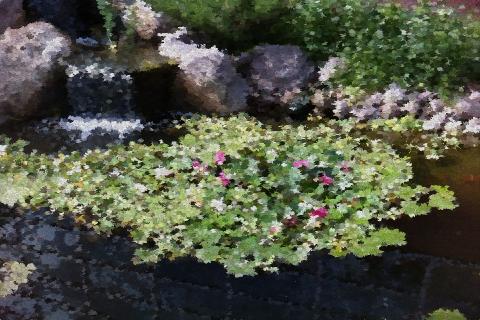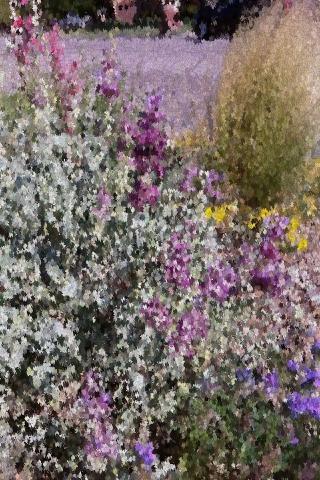
High Plains Gardening
The gardening website of the Texas High Plains Region
One of the most beautiful and most visited gardens in the world is Claude Monet's garden at Giverny, fifty miles northwest of Paris, in Normandy, France. Forty years in the making and refining of Clos Normand, the Grand Alleé and the renowned water lily gardens at his Giverny home, Monet was known as much for his skill and artistry in gardening as in painting. Many of the color harmonies, color effects and design techniques Monet implemented were new to his day and still repeated in garden designs today.
Brief History
Passing by Giverny by train one day, Monet spotted an empty pink house in this quiet, quaint village outside of the hustle and bustle of Paris. In 1883, Monet moved from Vétheuil with his sons (Camille having died in 1879) and Alice Horschede's large family to the pink house, first, as a renter. Monet immediately began planting a large kitchen garden with vegetables for the table and flowers for the soul. Much of the initial work was done by Monet himself, often working from dawn to dusk. Monet so loved gardening he considered it the “greatest form of art” and spent many hours engrossed in plant and seed catalogs, seeking out new plants, new varieties and hybrids. Monet once said, “ I perhaps owe having become a painter to flowers.” When he wasn't gardening, Monet was painting country and river side scenes from Giverny and Normandy, as well as impressions directly from his garden.
After several successful exhibitions and sales of his paintings, Monet was able to purchase the pink crushed brick Renaissance style home in 1890. Two years later, he and Alice (Horschedé), now married, acquire the nearby 2 ½ acre Maison Bleue for a new kitchen garden, and in 1893, purchased the strip of land across the railroad tracks where he created his famous water lily garden. In 1901, with the purchase of additional land south of the Ru River, Monet petitioned the town for additional water rights, which tripled the size of the water pond. Concurrently, gardeners are hired, six in all, to help in the installation and maintenance of all the garden areas. By 1895, Monet began work on the first of the water lily series of paintings that eventually totals nearly 250 paintings, almost a tenth of his total life's work.
As with many gardens, once the gardener takes his leave, the garden falls into disrepair. Such was the case upon Monet's death in 1926. Blanche Horschedé Monet, Claude's daughter-in-law, followed by Michel Monet, Claude Monet's son, supervised the upkeep of the gardens until 1966. Over a decade later, the garden was renovated and restored to its original glory and opened for the first time to the public in May, 1980. (Click here to view video of Monet's Garden.) Each year, over 500,000 visitors stream in to admire his skill and artistry, his vision, his impressions of color and light. What was real was imagined, and what he imagined became real.
What makes Monet's garden so loved and appreciated, is not just for his painterly inspirations, but for the garden's riotous waves of color, its brilliancy and succession of brilliancy, and especially its color harmonies. Coordinated hardscape throughout the gardens and home exterior tied home and garden together. House shutters, window frames, doors, steps, railings, trellises, arbors, arches, benches, even a wheelbarrow and boats on the pond were all painted the same shade and hue of apple green. Drifts of pink climbing roses, rose and peony standards and rose bushes throughout the garden echoed the pink of the home's pink crushed brick, framed by pink gravel paths. Pink flowering aubrieta, rock cress, edged the paths along many beds.
 With a garden covering several acres, Monet wasn't content with ground level plantings, but painted the landscape vertical space from the ground to the sky with flowers and foliage. In addition to trellises, arbors and arches, planters with obelisks for vines to climb, planters for standard roses, peonies and lilacs, and special tuteurs to “train” a pink climbing rose grafted onto a standard rose trunk (which in turn was grafted on to an old hardy rose rootstock) filled the spaces above. Even across the many paint box plantings, Monet fashioned arbors that spanned horizontally across the double row and grew Clematis montana, a vine that resembled a lace curtain hanging down when in bloom.
With a garden covering several acres, Monet wasn't content with ground level plantings, but painted the landscape vertical space from the ground to the sky with flowers and foliage. In addition to trellises, arbors and arches, planters with obelisks for vines to climb, planters for standard roses, peonies and lilacs, and special tuteurs to “train” a pink climbing rose grafted onto a standard rose trunk (which in turn was grafted on to an old hardy rose rootstock) filled the spaces above. Even across the many paint box plantings, Monet fashioned arbors that spanned horizontally across the double row and grew Clematis montana, a vine that resembled a lace curtain hanging down when in bloom.
Careful placement of paths, walkways and gates tied Clos Normand (as he called his flower garden) together with the Japanese influenced water lily garden, although it was across a road and railroad tracks. The Grand Alleé was centered with his home, leading down to a great gate. When the gates were open, the line of sight ran to the gate, to the Japanese bridge, to the water garden and across to a second bridge across the River Ru (across the road and tracks).
Gardens of the nineteenth century consisted of clipped, formal hedges, linear or knot patterns resembling paisley or embroidery. Flowers were planted to create color fields. Monet's garden was an extravagant departure from restraint. Clos Normand, Monet's garden on the house side of the railroad tracks, consisted of many garden areas, including island beds up close to the house, the Grand Alleé, 172 feet long by 22 feet wide, a double row of 19 paint box gardens (38 in all) with perennials beds running the length of the double rows, rose and iris perennial beds, monochrome perennial beds, trial beds called growing fields, and various lawn, shrub and tree beds for strolling and sitting.
Visitors to Monet's garden reveled in its floral opulence from ground to sky, from the heady fragrances of acres of flowers and for the diversity of color compositions, not just for a week or month, but May through October in an ever changing wave.
Monet's Color Harmonies
Monet was not just planting a garden, he planned gardens that would become future works of art. Monet departed from the formal boxwood hedge gardens, experimenting with color harmonies and combinations, using a technique he called paint box plantings, in beds 5 feet long by 2 ½ feet wide. The soil was well amended with compost, rotted manure and/or leaf mold. The 38 paint box gardens were edged with mauve aubrieta, planted 12 inches apart. Lavender was planted along the inner edge down the row of paint boxes to create a unifying alleé look.
Within the boxes was the magic. Color harmonies, the effect of partnering flower colors opposite each other on the color wheel coupled with the knowledge of perfect timing of the flowers in bloom, was his specialty. The paint boxes were like a drawing pad where he would practice and paint with plants until the combination was perfect. These flower compositions were planned and planted to come into bloom together with the aim as subjects for the canvas. Monet would paint from first light throughout the growing season, working on several canvases bed to bed as the light changed. Monet was interested in the fleeting moment, the impression of light on flower and plant, rather than for sustained floral show. However, in many cases, he achieved both objectives.
Favorite color harmonies were blue, pink and white; yellow blue and purple; blue, yellow and orange; orange and blue; yellow, orange and black; and red, green, silver and pink. His theory was that the combination of two primary colors, whether mixed or placed close to each other, will produce a compound color. Red and yellow will appear orange, blue and red – purple, yellow and blue fuse to make green. These effects were achieved by Impressionist painters on the canvas, most visually by the pointillist painters, such as George Seurat.
As with his paintings, he noted all flower colors were made brighter by the proximity of white and often improves poorer color pairings, such as clashing red and orange, dull red and purple and dark blue and purple. Conversely, all colors except for white are weakened by the closeness of black.
Some paint box gardens would contain analogous color harmonies: flaming red, orange and yellow flowers for a “hot” combination, alternating with pastel boxes of pastel shades of blue, pink and purple – “cool” combinations, and blue, purple and green – “cool harmony”. Islands of blue flowers create a calming effect; blue in shade is particularly relaxing.
To stimulate interest and excitement in the garden, he employed color contrast to heighten tension, attract attention. Yellow and purple; orange and blue, red, pink and green; black and white, black and orange, silver foliage with red and green contrast noticeably.
Still other plant paint boxes featured monochromatic color harmonies, all white, all red, all yellow, all blue, etc., while subtly improving the combinations with the addition of a few plants of contrasting color, such as a bit of yellow, silver or cream colored flowers in a white garden; shades of pink to a red, and a pale yellow or white to a blue garden.
Even in the softer light of cloudy and foliage rich Normandy, Monet avoided all white gardens. Here in the southwest, they would be blinding in open areas.
Monet employed the harmonizing effects of green foliage, playing the nuances of tone of this dominant color. Combining texture, shape, size and pattern to tone produces a rich tapestry in itself. Accenting with blue, bronze, silver and gray foliage can create rich and soothing color harmonies. Monet's lily pond garden exemplifies these techniques.
Other design elements
Control To offset the informality of his plantings, Monet kept aspects of formal construction and straight lines that gave a perception of order and containment to riotous beds. Lawns and paths were used to separate areas, giving the eye time to adjust to new design schemes, to keep the eye fresh and avoid overwhelming and tiring visitors to his garden. Or such was the plan. By late summer and fall, the garden burst forth, both upward and outward, spilling onto the pathways, softening, indeed, covering the hard edges.
Exhuberance Monet's garden is acclaimed for its exuberant nature. Exuberance was achieved by overcrowding, the plants heartiness supported by heavily amending beds. His team of gardeners kept the garden fresh by daily dead-heading, evading the spent meadow look and filling in with plants from the greenhouse. Monet aimed for one or two plants (planted en mass) with large flowers, brilliant in color, to be the main attraction, adding dazzle to the garden, with other supporting players in the background and foreground--their supporting cast.
Shimmering The paint box planters helped Monet to hone in on the effect of light on flowers. The changing effect of light was of primary interest to Monet, the impression he needed for his other art, his paintings. Shimmering light was created by sprinkling white and light yellow throughout the garden using delicate, airy flower panicles such as feverfew, tansy, daisies, asters, larkspur, Jupiter's Beard, and European columbines. Translucent petals of hollyhock, cosmos and poppy shimmered when backlit. California poppies provide an incandescent quality. Underplanting added to the shimmer. Flowers with black and white bicolor petals and black rays with yellow centers increased the twinkling effect.
Closely tied with the shimmering effect was the way Monet planted to see through flowers. He chose plants that were light and airy for the effect not just of shimmering light, but to see other colors in the spaces between foliage and flower. Arranging the beds in the long linear manner, row by row, contributed to the effect when viewed from many angles.
Framing Just as paintings are held in a frame, so too were Monet's flower beds. Compositions were framed by aubrieta and lavender, dianthus and geraniums (pelargoniums); iris, aubrieta and lavender; and nasturtiums. Round river rocks, bricks placed on the diagonal and pathways with a low border made from bent limbs or bamboo canes were other framing materials used. Stone walls with wrought iron and bridges, all painted in the same apple green framed other compositions throughout the gardens. Narrow pink gravel pathways and strips of lawn both framed and separated one bed from another.
One of the most beautiful and natural methods Monet used to frame and focus a view was the selection and use of trees with the structure and framework of branches as they radiated from the center trunk out, across, over and down in the water lily pond garden. Trees were pruned to create openings in the sky to allow for sunrise and sunset reflections. Where a massing of trees and their resulting shade wasn't desirable, trellis, arbors and arches displayed wisteria, passion vine, ivy, morning glory, clematis and climbing roses in the Clos Normand garden.
What Monet achieved was a masterpiece, twice over – that he repeated again and again in his paintings. Monet demonstrated, then created; created, then demonstrated. Such a garden does not come cheaply, nor with thrift. Much of his earnings from the sale of paintings was funneled back into the gardens, one art feeding the other.
 Monet on the High Plains
Monet on the High Plains
Is gardening to this extent worth it, composing for the fleeting moment when the arrangement comes into bloom together for a week or two? Monet thought so. Would he have gardened the same on the Plains, under our conditions, in our climate? Part 2 explores that issue.
References
I hope you'll take some time to peruse the links, to see what today's re-creation of Monet's garden looks like. There are many other Youtube videos in addition to the one referenced below.
Derek Fell, The Magic of Monet's Garden, His Planting Plans and Color Harmonies, Firefly Books, 2007.
Elizabeth Murray, Monet's Passion, Ideas, Inspiration and Insights from the Painter's Gardens, Pomegranate, 2010 revised edition.
Giverny website, http://giverny.org/gardens/fcm/visitgb.htm, includes many links about the gardens, plants and area.
On Point with Tom Ashbrooke, The Art of Monet's Garden, http://onpoint.wbur.org/2012/07/13/the-art-of-monets-garden, July 13, 2012.
New York Botanical Gardens, nybg.org and special exhibit, Monet's Garden, http://www.nybg.org/exhibitions/2012/monet/index.php.
Iphone app, NYBG in Bloom.
William Grimes, “Monet at the Home Depot”, New York Times, July 11, 2012.
Youtube video with head gardener, James Priest, https://www.youtube.com/watch?v=6b_-uHsDf4c.
Angie Hanna, July 10, 2013